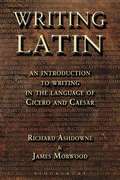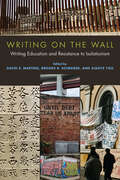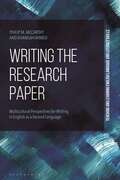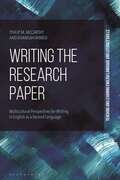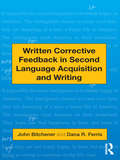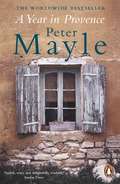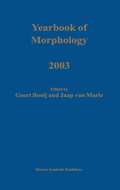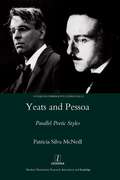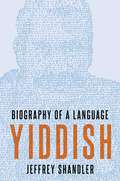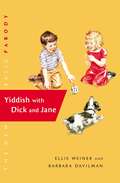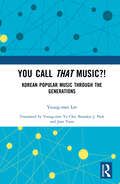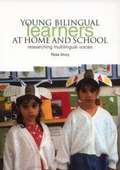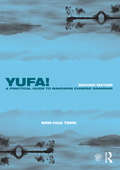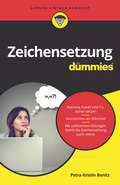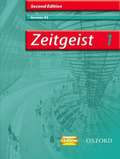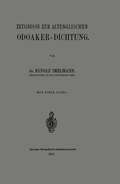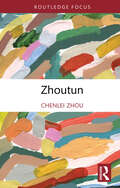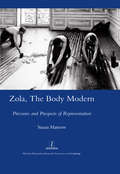- Table View
- List View
Writing Latin
by James Morwood Richard AshdowneA completely new guide to writing Latin from scratch, this user-friendly book includes key features such as: broad coverage - all the major grammatical constructions of the Latin language are covered, reinforcing what students have learnt from reading Latin; thorough accessible explanations - no previous experience of writing in Latin assumed; hundreds of examples - clear accurate illustrations of the constructions described, all with full translations; over six hundred practice sentences - graduated exercises leading students through three levels of difficulty from elementary to advanced level;introduction to Latin word order - a brief guide to some of the most important principles; and, longer passages for practising continuous prose composition - more challenging passages to stretch the most able students.It also includes features such as: commentaries on examples of Latin prose style - passages from great Latin prose writers focus attention on imitating real Latin usage; and, complete list of vocabulary - all the words needed for the exercises and a valuable reference for English-Latin work in general.
Writing on the Wall: Writing Education and Resistance to Isolationism
by Xiaoye You David S. Martins Brooke R. SchreiberThe first concerted effort of writing studies scholars to interrogate isolationism in the United States, Writing on the Wall reveals how writing teachers—often working directly with students who are immigrants, undocumented, first-generation, international, and students of color—embody ideas that counter isolationism. The collection extends existing scholarship and research about the ways racist and colonial rhetorics impact writing education; the impact of translingual, transnational, and cosmopolitan ideologies on student learning and student writing; and the role international educational partnerships play in pushing back against isolationist ideologies. Established and early-career scholars who work in a broad range of institutional contexts highlight the historical connections among monolingualism, racism, and white nationalism and introduce community- and classroom-based practices that writing teachers use to resist isolationist beliefs and tendencies. “Writing on the wall” serves as a metaphor for the creative, direct action writing education can provide and invokes border spaces as sites of identity expression, belonging, and resistance. The book connects transnational writing education with the fight for racial justice in the US and around the world and will be of significance to secondary and postsecondary writing teachers and graduate students in English, linguistics, composition, and literacy studies. Contributors: Olga Aksakalova, Sara P. Alvarez, Brody Bluemel, Tuli Chatterji, Keith Gilyard, Joleen Hanson, Florianne Jimenez Perzan, Rebecca Lorimer Leonard, Layli Maria Miron, Tony D. Scott, Kate Vieira, Amy J. Wan
Writing the Research Paper: Multicultural Perspectives for Writing in English as a Second Language (Teaching and Learning English Language and Literacy Skills)
by Philip M. McCarthy Khawlah AhmedCovering both theoretical and practical approaches, Writing the Research Paper guides students studying in English as a second or additional language through the skills necessary for success in university-level writing and research. The book begins with theoretical considerations, such as research, argumentation and critical thinking. It then offers a broad range of practical assistance covering all aspects of the writing process, including topic selection, argument, counter-argument, paragraph structure and cohesion. The book is accompanied by a companion website, writingtheresearchpaper.com. The website hosts many features, including chapter summaries, exercises, quizzes, PowerPoints, additional learning material, and technology assistance. The website also hosts numerous authentic examples of student papers at each of the critical stages of the writing process.
Writing the Research Paper: Multicultural Perspectives for Writing in English as a Second Language (Teaching and Learning English Language and Literacy Skills)
by Philip M. McCarthy Khawlah AhmedCovering both theoretical and practical approaches, Writing the Research Paper guides students studying in English as a second or additional language through the skills necessary for success in university-level writing and research. The book begins with theoretical considerations, such as research, argumentation and critical thinking. It then offers a broad range of practical assistance covering all aspects of the writing process, including topic selection, argument, counter-argument, paragraph structure and cohesion. The book is accompanied by a companion website, writingtheresearchpaper.com. The website hosts many features, including chapter summaries, exercises, quizzes, PowerPoints, additional learning material, and technology assistance. The website also hosts numerous authentic examples of student papers at each of the critical stages of the writing process.
Written Corrective Feedback in Second Language Acquisition and Writing
by John Bitchener Dana R. FerrisWhat should language and writing teachers do about giving students written corrective feedback? This book surveys theory, research, and practice on the important and sometimes controversial issue of written corrective feedback, also known as “error/grammar correction,” and its impact on second language acquisition and second language writing development. Offering state-of-the-art treatment of a topic that is highly relevant to both researchers and practitioners, it critically analyzes and synthesizes several parallel and complementary strands of research — work on error/feedback (both oral and written) in SLA and studies of the impact of error correction in writing/composition courses — and addresses practical applications. Drawing from both second language acquisition and writing/composition literature, this volume is the first to intentionally connect these two separate but important lines of inquiry.
Written Corrective Feedback in Second Language Acquisition and Writing
by John Bitchener Dana R. FerrisWhat should language and writing teachers do about giving students written corrective feedback? This book surveys theory, research, and practice on the important and sometimes controversial issue of written corrective feedback, also known as “error/grammar correction,” and its impact on second language acquisition and second language writing development. Offering state-of-the-art treatment of a topic that is highly relevant to both researchers and practitioners, it critically analyzes and synthesizes several parallel and complementary strands of research — work on error/feedback (both oral and written) in SLA and studies of the impact of error correction in writing/composition courses — and addresses practical applications. Drawing from both second language acquisition and writing/composition literature, this volume is the first to intentionally connect these two separate but important lines of inquiry.
A Year in Provence (Popular Penguins Series)
by Peter MayleThe bestselling, much-loved classic account of an English couple enjoying the fruits of French rural living - an irresistible feast of humour and heart.Peter Mayle and his wife did what most of us only imagine doing when they made their long-cherished dream of a life abroad a reality: throwing caution to the wind, they bought a glorious two hundred year-old farmhouse in the Lubéron Valley and began a new life.In a year that begins with a marathon lunch and continues with a host of gastronomic delights, they also survive the unexpected and often hilarious curiosities of rural life. From mastering the local accent and enduring invasion by bumbling builders, to discovering the finer points of boules and goat-racing, all the earthy pleasures of Provençal life are conjured up in this enchanting portrait.'One of the most successful travel books of all time... Mayle created a new travel genre' GuardianDelightful' Washington Post'Engaging, funny and richly appreciative' New York Times Book Review'Stylish, witty, delightfully readable' Sunday Times'I really loved this book' Julia Child
Yearbook of Morphology 2003 (Yearbook of Morphology)
by GEERT BOOIJ and JAAP VAN MARLEThe Yearbook of Morphology series, published since 1988, has proven to be an eminent support for the current upswing of morphological research and has set a standard for morphological research. The 2003 volume deals with the phenomenon of complex predicates consisting of a verb preceded by a preverb, presents historical evidence on the change of preverbal elements into prefixes, and discusses morphological parsing, and the role of paradigmatical relations in analogical change. It is relevant to theoretical, descriptive, and historical linguists, morphologists, phonologists, computational linguists, and psycholinguists.
Yeats and Pessoa: Parallel Poetic Styles
by Patricia Silva-McNeillW. B. Yeats and Fernando Pessoa (1888-1935) regarded style as a tool for metaphysical inquiry and, consequently, they adopted distinct poetic styles to convey different attitudes towards experience. Silva-McNeill's study examines how the poets' stylistic diversification was a means of rehearsing different existential and aesthetic stances. It identifies parallels between their styles from a comparative case studies approach. Their stylistic masks allowed them to maintain the subjectivity and authenticity associated with the lyrical genre, while simultaneously attaining greater objectivity and conveying multiple perspectives. The poets continuously transformed the fond and form of their verse, creating a protean lyrical voice that expressed their multilateral poetic temperament and reflected the depersonalisation and formal experimentalism of the modern lyric.
Yeats and Pessoa: Parallel Poetic Styles
by Patricia Silva-McNeillW. B. Yeats and Fernando Pessoa (1888-1935) regarded style as a tool for metaphysical inquiry and, consequently, they adopted distinct poetic styles to convey different attitudes towards experience. Silva-McNeill's study examines how the poets' stylistic diversification was a means of rehearsing different existential and aesthetic stances. It identifies parallels between their styles from a comparative case studies approach. Their stylistic masks allowed them to maintain the subjectivity and authenticity associated with the lyrical genre, while simultaneously attaining greater objectivity and conveying multiple perspectives. The poets continuously transformed the fond and form of their verse, creating a protean lyrical voice that expressed their multilateral poetic temperament and reflected the depersonalisation and formal experimentalism of the modern lyric.
Yiddish: Biography of a Language
by Jeffrey ShandlerThe most widely spoken Jewish language on the eve of the Holocaust, Yiddish continues to play a significant role in Jewish life today, from Hasidim for whom it is a language of daily life to avant-garde performers, political activists, and LGBTQ writers turning to Yiddish for inspiration. Yiddish: Biography of a Language presents the story of this centuries-old language, the defining vernacular of Ashkenazi Jews, from its origins to the present. Jeffrey Shandler tells the multifaceted history of Yiddish in the form of a biographical profile, revealing surprising insights through a series of thematic chapters. He addresses key aspects of Yiddish as the language of a diasporic population, whose speakers have always used more than one language. As the vernacular of a marginalized minority, Yiddish has often been held in low regard compared to other languages, and its legitimacy as a language has been questioned. But some devoted Yiddish speakers have championed the language as embodying the essence of Jewish culture and a defining feature of a Jewish national identity. Despite predictions of the demise of Yiddish-dating back well before half of its speakers were murdered during the Holocaust-the language leads a vibrant, evolving life to this day.
Yiddish: Biography of a Language
by Jeffrey ShandlerThe most widely spoken Jewish language on the eve of the Holocaust, Yiddish continues to play a significant role in Jewish life today, from Hasidim for whom it is a language of daily life to avant-garde performers, political activists, and LGBTQ writers turning to Yiddish for inspiration. Yiddish: Biography of a Language presents the story of this centuries-old language, the defining vernacular of Ashkenazi Jews, from its origins to the present. Jeffrey Shandler tells the multifaceted history of Yiddish in the form of a biographical profile, revealing surprising insights through a series of thematic chapters. He addresses key aspects of Yiddish as the language of a diasporic population, whose speakers have always used more than one language. As the vernacular of a marginalized minority, Yiddish has often been held in low regard compared to other languages, and its legitimacy as a language has been questioned. But some devoted Yiddish speakers have championed the language as embodying the essence of Jewish culture and a defining feature of a Jewish national identity. Despite predictions of the demise of Yiddish-dating back well before half of its speakers were murdered during the Holocaust-the language leads a vibrant, evolving life to this day.
Yiddish with Dick and Jane
by Ellis Weiner Barbara DavilmanJane is in real estate. Today is Saturday. Jane has an open house. She must schlep the Open House signs to the car. See Jane schlep. Schlep, Jane. Schlep. Schlep, schlep, schlep. In text that captures the unque rhythms of the original Dick and Jane readers, and in 35 all-new illustrations, a story unfolds in which Dick and Jane -- hero and heroine of the classic books for children that generations of Americans have used when learning to read -- manage to express shades of feeling and nuances of meaning that ordinary English just can't deliver. How? By speaking Yiddish, employing terms that convey an attitude -- part plucky self-assertion, part ironic fatalism. When Dick schmoozes, when Jane kvetches, when their children fress noodles at a Chinese restaurant, the clash of cultures produces genuine hilarity.
You Call That Music?!: Korean Popular Music Through the Generations
by Young-mee LeeYou Call That Music?!: Korean Popular Music Through the Generations provides a critical overview of the history of Korean popular music from 1920 to the 2000s from the perspective of cultural history. First published in Korean in 2017 by one of the best-known critics, Lee Young-Mee, this book is a timely and much-needed source of information on Korean popular music of the past hundred years. Through this English translation, readers are able to make meaningful connections between specific forms of Korean popular music of various periods and the contemporaneous Korean social and political circumstances. Structured around the central theme of generational conflict, the book provides readers with an accessible way to engage with Korea’s social history and a greater understanding of how specific musical works, genres and styles fit into that history. Its strong narrative force helps illuminate the connections between modern Korean social history and the particular trends of musical production and their reception through the decades. You Call That Music?! is an invaluable resource for those researching and studying Korean popular music specifically as well as Korea’s cultural and social history.
You Call That Music?!: Korean Popular Music Through the Generations
by Young-mee LeeYou Call That Music?!: Korean Popular Music Through the Generations provides a critical overview of the history of Korean popular music from 1920 to the 2000s from the perspective of cultural history. First published in Korean in 2017 by one of the best-known critics, Lee Young-Mee, this book is a timely and much-needed source of information on Korean popular music of the past hundred years. Through this English translation, readers are able to make meaningful connections between specific forms of Korean popular music of various periods and the contemporaneous Korean social and political circumstances. Structured around the central theme of generational conflict, the book provides readers with an accessible way to engage with Korea’s social history and a greater understanding of how specific musical works, genres and styles fit into that history. Its strong narrative force helps illuminate the connections between modern Korean social history and the particular trends of musical production and their reception through the decades. You Call That Music?! is an invaluable resource for those researching and studying Korean popular music specifically as well as Korea’s cultural and social history.
Young Bilingual Learners at Home and School: Researching Multilingual Voices (PDF)
by Rose DruryBased on the author's ethnographic study, this book examines the experiences of three four-year-old bilingual children as they begin school in three English nursery classes. It thus provides insights into young children's use of first languages as well as English, so provides a fuller and richer picture of bilingual children's learning. The book reveals some of the ways young bilingual children experience nursery as they begin to learn the language required for formal schooling. It demonstrates how they take control of their own learning at home. And it asks questions: How do Samia, Maria and Nazma find their own way through nursery? What are their individual strategies for getting by and, beyond that, for learning during their first year of formal schooling? How do they syncretise home and school learning? The detailed picture that emerges fills in the detail missing from the current over-generalised view of bilingual children in the early years and provides an important new perspective to a growing body of literature on young bilinguals. It will be essential reading for all teachers, early childhood practitioners and early years policy makers operating in multilingual environments.
Yufa! A Practical Guide to Mandarin Chinese Grammar (Routledge Concise Grammars)
by Wen-Hua TengYufa! A Practical Guide to Mandarin Chinese Grammar takes a unique approach to explaining the major topics of Mandarin Chinese grammar. The book is presented in two sections: the core structures of Chinese grammar, and the practical use of the Chinese language. Key features include: Chinese characters, pinyin and English translations Realistic scenarios to provide you with an interesting context in which to learn grammar Varied and imaginative exercises so you can review your progress easily.With straightforward descriptions, numerous exercises, and examples that are rooted in realistic situations, the author shows you how grammar is used in everyday life. This new second edition has been fully revised and updated throughout and continues to be one of the clearest and most comprehensive pedagogical grammars available.
Yufa! A Practical Guide to Mandarin Chinese Grammar (Routledge Concise Grammars)
by Wen-Hua TengYufa! A Practical Guide to Mandarin Chinese Grammar takes a unique approach to explaining the major topics of Mandarin Chinese grammar. The book is presented in two sections: the core structures of Chinese grammar, and the practical use of the Chinese language. Key features include: Chinese characters, pinyin and English translations Realistic scenarios to provide you with an interesting context in which to learn grammar Varied and imaginative exercises so you can review your progress easily.With straightforward descriptions, numerous exercises, and examples that are rooted in realistic situations, the author shows you how grammar is used in everyday life. This new second edition has been fully revised and updated throughout and continues to be one of the clearest and most comprehensive pedagogical grammars available.
Zeichensetzung für Dummies (Für Dummies)
by Petra-Kristin BonitzIst bei Ihnen die Zeichensetzung eher Gefühlssache? Sind Sie manchmal unsicher, wo ein Komma stehen muss und wo nicht? Dann schafft dieses Buch Abhilfe! Systematisch und gut verständlich erklärt Ihnen Petra-Kristin Bonitz, warum Satzzeichen gesetzt werden. Sie bringt Ihnen Satzstrukturen wieder ins Gedächtnis und erklärt anschaulich die Regeln, aber auch die Freiheiten im Rahmen der Zeichensetzung. Erfahren Sie zum Beispiel, ob und wie Sie Kommas bei Aufzählungen, Nebensätzen oder Infinitiven mit ?zu? setzen oder das eher exotische Semikolon verwenden. Darüber hinaus lassen sich Satzzeichen als Stilmittel einsetzen - Gedankenstrich, runde Klammern oder doch lieber der Doppelpunkt? Zahlreiche Übungen helfen Ihnen, das Gelernte anzuwenden und zu trainieren.
Zeitgeist 1. German AS (PDF)
by Morag Mccrorie Dagmar Sauer Ann AdlerThis new 2008 edition of this popular course has been fully revised to support the new specifications.
Zhoutun (Routledge World Languages)
by Chenlei ZhouThis book presents a description of the grammar of Zhoutun, an endangered Sinitic variety spoken by less than 1000 people in the Qinghai Province of northwest China. With vocabulary predominantly from Chinese and Tibetan syntax, Zhoutun is one of the Sinitic varieties most distant from Standard Chinese, with unexpected typological features like, for example, case markers, rigid SOV word order, simplified tonal system, negative copula as a disjunctive coordinator and "locutor-referential pronoun" which is not found in Chinese and in many languages. Zhoutun is also a representative variety of the Gansu-Qinghai linguistic area in which Mongolic and Turkic languages coexist with Tibetan and Chinese dialects from a long time. This book also describes the sociolinguistic and sociohistorical contexts of Zhoutun. It should be of interest to specialists and students of language contact, linguistic typology, Chinese dialectology, language geography, anthropological linguistics, sociolinguistics, folklore studies, and preservation of endangered languages.
Zhoutun (Routledge World Languages)
by Chenlei ZhouThis book presents a description of the grammar of Zhoutun, an endangered Sinitic variety spoken by less than 1000 people in the Qinghai Province of northwest China. With vocabulary predominantly from Chinese and Tibetan syntax, Zhoutun is one of the Sinitic varieties most distant from Standard Chinese, with unexpected typological features like, for example, case markers, rigid SOV word order, simplified tonal system, negative copula as a disjunctive coordinator and "locutor-referential pronoun" which is not found in Chinese and in many languages. Zhoutun is also a representative variety of the Gansu-Qinghai linguistic area in which Mongolic and Turkic languages coexist with Tibetan and Chinese dialects from a long time. This book also describes the sociolinguistic and sociohistorical contexts of Zhoutun. It should be of interest to specialists and students of language contact, linguistic typology, Chinese dialectology, language geography, anthropological linguistics, sociolinguistics, folklore studies, and preservation of endangered languages.
Zola, The Body Modern: Pressures and Prospects of Representation
by Susan HarrowEmile Zola's reputation as a landmark European novelist is undisputed. His monumental achievement, the novel cycle Les Rougon-Macquart: Histoire sociale et naturelle d'une famille sous le Second Empire (1871-1893), fixed his status as a major writer in the naturalist tradition. Is there any more to be said? Susan Harrow answers boldly in the affirmative, challenging the commonplace view that Zola's writing is predictable, prolix and transparent (what Barthes called 'readerly', for which read 'tedious'). Harrow exposes the modernist and postmodernist strategies which surface in the Rougon-Macquart novels, and reveals Zola's innovatory representation of the body captured here at work, at war, at play, at rest, and in arresting abstraction. Informed by critical thought from Barthes and Deleuze to Michel de Certeau and Anthony Giddens, Zola, the Body Modern offers a model for how we can revitalize our understanding of the canonical nineteenth-century European novel, and learn to travel more flexibly between parameters of century, style and aesthetics.
